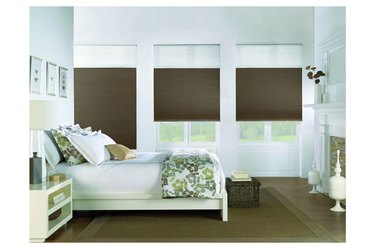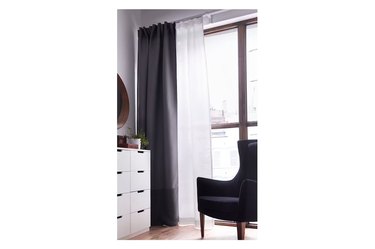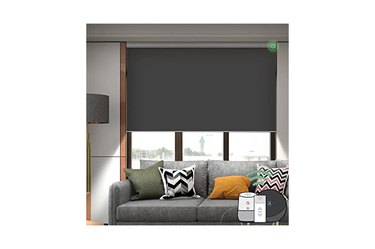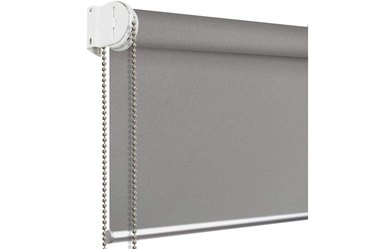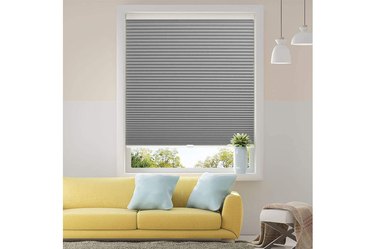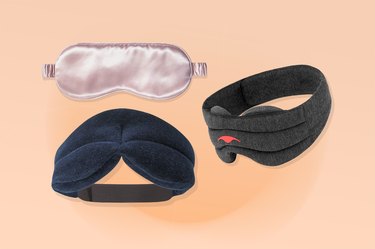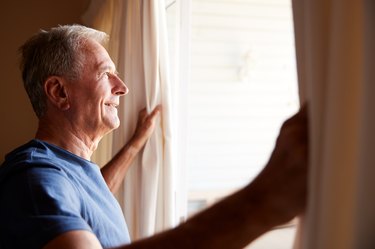
Have you ever found it hard to sleep when the sun is still up or there's a light on in your room? There's a good reason for that — and it's not because you're ultra-sensitive to light.
Light in the bedroom can throw off your circadian rhythm and confuse your body, keeping you from staying in the crucial deep sleep stages, says Stephen Light, certified sleep science coach and CMO and co-owner of Nolah Mattress.
Video of the Day
Video of the Day
"Light stimulates us and makes us alert, both of which are barriers to getting the good quality sleep we need to function, while a dark room triggers a response in our brains that make falling and staying asleep much easier," Light says.
Unfortunately, not all of us can afford to sleep only during the nighttime. Shift workers and new parents, for example, often need to sleep during daytime hours to ensure they're getting their fair share of shut-eye. And some of us live in cities where light constantly streams in our windows, or we're woken up by an early rising sun. Luckily for these people, there's an easy at-home solution: blackout blinds.
Put simply, blackout blinds are dark window treatments made to eliminate as much light as possible. "They are often made of an entirely opaque fabric that can block light from entering through windows and are typically used in bedrooms, home theaters and dark rooms," Light explains.
Of course, blackout blinds go by myriad names, including blackout shades and room-darkening blinds and/or shades. The main difference, says Sunjya Schweig, MD, board-certified integrative family medicine physician and founder and president of the California Center for Functional Medicine, is that blackout shades block 100 percent of all incoming light, while room-darkening ones refer to any type of blind or shade that blocks between 95 and 99 percent of light.
"Essentially, room-darkening ones dramatically reduce incoming light, while blackout ones make your room nearly pitch black," he explains.
The Best Blackout Blinds
- Best Overall: Bali Blackout Cellular Shades ($68.49, Home Depot)
- Best on a Budget: IKEA Majgull Blackout Curtains ($39.99, IKEA)
- Best Motorized: Yoolax Motorized Shade ($169, Amazon)
- Best for Kids: Passenger Pigeon Blackout Window Shades ($44.99, Amazon)
- Best Cordless: SBARTAR Window Shades Cordless Blackout Fabric Blinds ($53.99, Amazon)
How We Chose
We chatted with sleep specialists to get their perspective on the best blackout blinds for a better night's sleep and how to find your perfect product. We chose our top picks based on their personal recommendation and criteria including:
- Light-blocking abilities
- Ease of set up
- Style and fabric
1. Best Overall: Bali Blackout Cellular Shades
There pretty much isn't a color you cannot order these quality blackout shades in. From pinks to blues to grays and browns, Home Depot covers all your bases when it comes to shades that will work well with your room's color scheme.
They not only block out brightness, but they also manage room temperature thanks to quality insulation and offer cordless controls, which can be beneficial when using in children's rooms.
They're also completely customizable, with variations ranging from 10 to 144 inches wide.
Buy it: HomeDepot.com; Price: $68.49
2. Best on a Budget: IKEA Majgull Blackout Curtains
Though they don't provide the level of darkness some people are looking for when they purchase blackout blinds, these curtains come close to their competitors at a fraction of the price.
"Aesthetically pleasing and (cost) effective, they get the job done, especially for tweens, teens and tired college students," notes Christina Pierpaoli Parker, PhD, licensed clinical psychologist and incoming director of the Integrated Behavioral Medicine Service at the University of Alabama at Birmingham (UAB).
They're also thick enough to keep the heat out during the summer and the drafty, cold air from coming in during the winter.
Buy it: IKEA.com; Price: $39.99
3. Best Motorized: Yoolax Motorized Shades
If you're looking for blackout blinds for a room with large windows, whether that's your bedroom or, perhaps, a living room, these shades are quite convenient. You can roll them up or down using a remote control that also can be activated using voice controls with Alexa or Google Home.
They come in a wide range of colors, too, and can be made to order if you're looking for specific sizing.
Buy it: Amazon.com; Price: $169
4. Best for Kids: Passenger Pigeon Blackout Window Shades
Roller blinds are ideal for children's rooms, as they can create a dark room even on the brightest of days, Dr. Schweig says. This brand is the one he recommends because the shades effectively block out both light and UV rays, are made from a waterproof fabric and are easy to clean due to the heavy duty polyester material.
"Additionally, they are thermally insulated, which is a good choice for windows that get a lot of sunlight throughout the day or for French doors," he adds.
Buy it: Amazon.com; Price: $44.99
5. Best Cordless: SBARTAR Cordless Blackout Blinds
Sometimes blinds you have to pull down with a cord can be a pain, especially if that cord gets compromised in any way. You may also want to skip the cord for aesthetic purposes, or as a safety precaution if you have little ones in the house.
These blinds fit the bill and couldn't be easier to use — just pull them down or push them up. In addition to their blackout liner that blocks all incoming light, they are also made using a special cellular material that blocks out harmful UV rays.
"They additionally help with noise reduction and heat/cold protection, helping to conserve energy use in the home," Dr. Schweig adds.
Buy it: Amazon.com; Price: $53.99
What to Consider When Buying Blackout Blinds
1. Darkness Factor
Blackout blinds can vary when it comes to how much light they block out, so it's a good idea to know what you're looking for as far as how much, if any, light you want to come through.
"If you're uncomfortable with a room being 100 percent pitch black, then you likely want to opt for a room-darkening solution over a blackout curtain," says Light. "If you want a true blackout, look for curtains made of fiberglass, polyester, cellulose and other materials that offer truly opaque conditions."
2. Your Space
Before you purchase blackout blinds, it's a good idea to look at the space in which you're working with to determine what might work best.
"Blackout curtains require a lot more space than blackout blinds and shades because they must be installed with brackets that lay wider than the window itself," explains Light. "With blinds and shades, the material lies flush with the window frame, so if you have less space, they could be a better option."
3. Material
The material you go with for your blackout blinds will determine their durability. For example, certain materials might break down in very hot climates, warns Dr. Schweig. He also suggests deciding whether or not you prefer a material that is waterproof and dust-resistant.
"A lot of dust particles can stick to blackout blinds, and if you don't clean them properly and regularly, they can pose a major hygiene problem for you and your family," he says.
4. Design
Blackout blinds can come in a wide range of designs, from roller blinds and pleated blinds to Venetian or Roman-style blinds. Dr. Schweig recommends making sure you get functionality and style in equal measure.
- Stephen Light, certified sleep science coach and CMO and co-owner of Nolah Mattress
- Sunjya Schweig, MD, an expert in complex chronic illnesses and founder and president of the California Center for Functional Medicine
- Christina Pierpaoli Parker, PhD, licensed clinical psychologist and incoming director of the Integrated Behavioral Medicine Service at the University of Alabama at Birmingham (UAB).
Is this an emergency? If you are experiencing serious medical symptoms, please see the National Library of Medicine’s list of signs you need emergency medical attention or call 911.
